Summary of Lawrence Weiner
Lawrence Weiner was one of the pioneers of text-as-art during the era of Conceptualism. His use of language is notable for its lyricism, its inquisitive engagement with the material world around it, and its distinctive, often colorful and playful visual forms. A fiercely egalitarian and anti-authoritarian spirit, hailing from a working-class background, Weiner saw his artworks as invitations for viewers to reconsider their relationships with the world around them, including with other people and systems of power. Based between Amsterdam and his home city of New York for most of his career, Weiner remained an engaging and humane force within modern art for half a century, creatively active throughout.
Accomplishments
- Lawrence Weiner's work contributed to the so-called "dematerialization of the art object" defined by critic Lucy Lippard in 1973. This involved the replacement of visual and three-dimensional forms with linguistic ideas as the primary substance of art. This gesture, which defined Weiner's practice from 1968 onwards, was hugely influential on modern art across the late 20th century, from Post-Conceptualism and Post-Minimalism to book art, Performance art, and more.
- Weiner's use of language was notable for its lyricism, brevity, and visual beauty, in contrast with other Conceptual artists who often worked with more emotionally detached, sometimes long and repetitive textual forms. Weiner even designed his own typeface, Margaret Seaworthy Gothic, to convey the particular, poetic spirit of his work. As such, he endowed language with many of the qualities of aesthetic beauty and emotional depth that might previously have defined a more traditional artwork. Indeed, he saw himself as a sculptor working with words.
- Weiner wanted his art to communicate with his audiences in an open-ended and thought-provoking manner, without the baggage of 'high art.' He often chose to locate his works in public spaces, including on exterior walls and floors, rather than in galleries, and the language of his work often explored the material objects and processes around it, asking questions or making connections. In this way, his practice can often be seen as site-specific, though the artist himself always contested that description.
The Life of Lawrence Weiner
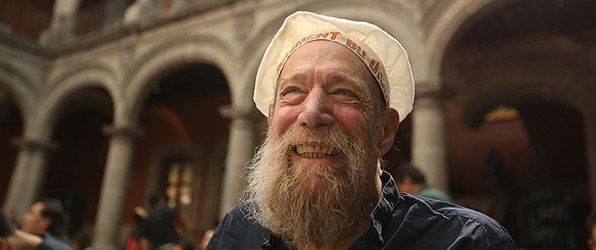
Lawrence Weiner's works make playful, probing interventions into the world around them. One of the first artists to work with text as his primary material, he rarely accepting teaching positions, as he was more interesting in questioning authority than assuming it.
Important Art by Lawrence Weiner
Title Unknown
This work, from Weiner's series of Propeller Paintings (1960-65), features a central sunburst- or propeller-like yellow form, set inside a larger red form with a similar shape. The background is comprised of geometric blue and orange fields, each outlined either by black lines or thicker gold lines. As with all of the works in the series, Weiner used readily available materials (or as he put it, materials that were not "exotic") to create the piece. Weiner's desire to present art as accessible, both to audiences and other would-be artists, would come to define his career.
Weiner said of his Propeller Paintings, "I was in a very distressed state about the political relation of the artist to society [...] I began to understand things that were being discussed in the context of the painting of emblems. I had an old television set which only had one channel, with signals that I watched all night. That became my modus operandi. I began to make these paintings, all in different sizes and all in different shapes and all at the same price." Looking back on these works later in his career, he conceded that although he thought them to be "important" and impressive at the time, he ultimately came to feel that they weren't.
The artist noted that this series led to the creation of three-dimensional pieces, including his "cut-out sculptures" of 1966 and his later "notched paintings". He had also already begun experimenting with immaterial, or so-called "conceptual" art projects, when he made his Propeller Paintings. In 1960 he created Cratering Piece, an undocumented, unsanctioned performance-based earthwork that involved detonating a series of explosives in a California state park and declaring the resulting "craters" to be sculptures. Thus, his Propeller Paintings came at a time when the artist was experimenting with both tangible, traditional art forms and with practices that challenged the object-status of painting and sculpture.
Synthetic polymer paint and sawdust on canvas - Museum of Modern Art, New York City
ONE QUART EXTERIOR GREEN INDUSTRIAL ENAMEL THROWN ON A BRICK WALL
This work, which comprises the title phrase written on a wall in green, is amongst the first of Weiner's text-based installations, which dominated his oeuvre from 1968 onwards. Weiner started producing these pieces after an incident at Windham College in Putney, when students cut down the twine that made up his outdoor sculpture Hay, Mesh, String (1968) to walk across the college lawn. It was at that point that Weiner realized the work would have functioned better as a simple verbal description rather than as a physical manifestation. Many of the works he created subsequently (including ONE QUART...) refer to materials and/or a physical action or process. By describing the process that created the artwork, Weiner invites audiences to break down the veil of mystery, rarefication, and secrecy that surrounds the idea of 'art' or 'artists,' implying that anyone could remake this piece or produce an equivalent piece of their own. He was therefore engaging in a subtly radical movement to democratize the discourses around modern art.
Weiner later described his shift towards using words as form as "a political decision. If you wanted to make something that everybody could get, the way to do that was to make something with genuine sculptural values and to portray it in a language so that people could be able to do it themselves. Not instructions. But something that sat by itself." As per his Declaration of Intent (1968) these text-based works do not need to be executed by the artist himself. Curator Ann Goldstein writes that "Weiner's employment of language allows the work to be used by its receiver. It is purposely left open for translation, transference, and transformation; each time the work is made, it is made anew. Not fixed in time and place, every manifestation and point of reception is different - each person will use the work differently and find a different relationship to its content."
Weiner considers his text-based works to be sculptural and lists the works' materials as "language + materials referred to". He says "I realized that I was working with the materials that people called 'sculptors' work with. I was working with mass, I was working with all of the processes of taking out and putting in [...] I also realized that I was dealing with very generalized structures in an extremely formalized one [...] we were all talking about the ideas generated by placing a sculpture in the world. Therefore I did not think I was doing anything different from somebody putting fourteen tons of steel out. [...] I finally realized that it was possible just to leave it in language."
Language + materials referred to - Collection of Alice Zimmerman-Wiener
Earth to Earth, Ashes to Ashes, Dust to Dust
In this text-based work, Weiner's words do not so much refer to an imagined or imaginable artistic intervention as open out a lyrical space for wide-ranging viewer interpretations. Curator Nancy Spector asserts that "[i]n a radical restructuring of the traditional artist/viewer relationship, Weiner shifted the responsibility of the work's realization to its audience, while also redefining standard systems of artistic distribution." She adds that "Weiner gradually extended his engagement with language to [include] ready-made structures, such as idioms, clichés, and proverbs, which underscore the contingent nature of meaning when encountered in different contexts. The Christian burial recitation 'Earth to Earth, Ashes to Ashes, Dust to Dust' becomes, in non-liturgical circumstances, a simple meditation on materials and processes of transmutation." Thus, whereas many of Weiner's works signify a kind of transparency of form, whereby the piece describes what it is made of, Earth to Earth embodies the more open-ended and allusive dimensions of his language. This is one of the most unique and engaging aspects of his practice as compared to Conceptualism in general.
In his early years, Weiner spent a great amount of time experimenting with sans-serif typefaces, trying to find the best one for his artistic purpose. He began by using Helvetica, which he described is "nice enough" although "sort of dumpy". However, he was soon turned off as he felt it had accrued an air of "intellectual power" and didn't like things "that get away with just having power". He then turned to Franklin Gothic but later said that "after a while, the work entered the culture so much that if anybody saw something in Franklin Gothic, they thought it was me and it wasn't". In the end, he developed his own unique typeface, Margaret Seaworthy Gothic.
Works such as Earth to Earth, Ashes to Ashes, Dust to Dust exemplify the difference between Weiner's approach to Conceptual Art (though he never accepted that term) and other artists associated with the movement such as Joseph Kosuth. Whereas both artists used language to describe an imagined visual or sculptural artwork that was not actually presented, Weiner's nuggets of language had a quality of self-sufficient aesthetic beauty that was often lacking in the more clinical, documentary style of Kosuth's texts. For this reason, Weiner is amongst those Conceptual Artists whose work has been appreciated by poets and compared to poetry as well as being placed in the company of art movements.
Language + materials referred to - Solomon R. Guggenheim Museum, New York City
A FIRST QUARTER
Weiner considered this film to be his "Godard movie". He was strongly influenced by Godard's A Bout de Souffle (1960) when it first came out, viewing it as "the first real work of Pop Art in film". He was most taken by Godard's "understanding of the relationships between reality and non-reality". In his own film, Weiner adopted many of the techniques used by Godard and other directors of Nouvelle Vague cinema, such as the presentation of simultaneous realities, altered flashbacks, and plays on time and space.
Says Weiner, "I started to make movies because I didn't want to write magazine articles [...] I am not a writer and so I'm better off making the movie, putting the mise-en-scène of how I wanted to present the emotional thing." He notes that in A FIRST QUARTER, "my major dialogue was existential: I decided to make a mise-en-scène that was closer to where my work could exist, and, in fact, cheapen its value within the society." The actors in the film are all artists, who at various times recite or write the names of artworks by Weiner. The work is imagined as a series of "simultaneous realities" along the lines of Godard's cinema. Structurally, the artist stated that the film adapts the form of a feature film.
Weiner went on to make a number of other films, such as DO YOU BELIEVE IN WATER? (1976), which he refers to as a "programmatic" and "very structured tape [...] about playing games", and which features a homosexual male character who feels uncomfortable around lesbian women. Also from 1976 is A BIT OF MATTER AND A LITTLE BIT MORE, which focuses on pornography as a political statement on how the United States government was imprisoning pornographers at the time.
Black-and-white video transferred to 16mm film - Museum of Modern Art, New York City
SOME LIMESTONE SOME SANDSTONE ENCLOSED FOR SOME REASON
Weiner sometimes incorporated a more explicitly sculptural element in his work, as in this three-dimensional piece which involved recasting the iron weighbridge of the former Dean Clough Carpet Factory and embossing the title-text onto the metal. Writer Naomi Blumberg notes that "[s]ome of Weiner's phrases are unique to one site, whereas others may be repeated or installed in multiple places - in a public space, on a gallery wall, in a book - each context carrying with it a different meaning and experience for the reader." Although the artist himself has repeatedly argued against the assertion that many of his works are site-specific, this work does refer precisely to the context and history bound up in its physical environment. Part of the value of Weiner's work is in drawing attention to the wider realities enclosing it, including the industrial and architectural materials and space around it. This gesture gave his Conceptual art more direct cultural and political relevance than the movement sometimes possessed.
The discussion as to whether any of his works belong in one place more than another was a source of disagreement between Weiner and many of his viewers and critics. For Weiner, "[t]he site is not terribly important. The concept of who your audience is becomes more important than your site. Sometimes you can be commissioned to do a piece in Strasbourg, and it works. Sometimes you're commissioned to do a piece somewhere else and it doesn't work, but then it moves to another city, the people embrace it, and becomes part of them. You just misjudged the needs of the people."
Nevertheless, the public setting of this and other works outside of gallery settings is an important aspect of their meaning. Blumberg notes that "a primary motivating factor behind Weiner's work was the desire to make it accessible, without needing to buy a ticket or understand a secret visual language. He contended that language reaches a broader audience [than other artistic media], and situating language in contexts outside traditional art-viewing settings, such as art museums, furthers that reach."
Embossed iron - Dean Clough Carpet Factory, Halifax, England
Forever and a Day
This work, which features written phrases in Weiner's characteristic style on the pavement of Mexico City's Zócalo square, also incorporates some of the simple graphic marks and lines he began including in his later work, when he felt that language could not fully speak for itself. Towards the end of his life, Weiner explained that his approach to his text-based art had shifted somewhat since he began creating such works in 1968. "When I started," he recalled, "I was under the misimpression of a Chomskyan idea that all language was universal and innate" (the linguist turned political commentator Noam Chomsky had, since the 1950s, proposed that there was a universal structure to world languages, so that all human cultures held certain aspects of their outlook on the world in common). "I am not so sure any longer, but I don't know the answer to that. I find that I have to look at something and determine what it's called, in order to be able to communicate it to somebody. I have to make gestures in the work that I do because language cannot accommodate what I'm trying to show. I feel that the negotiation is not one of information, it is a social one."
In spite of his sense in later years that language did not always contain self-sufficient meaning, Weiner continued to argue against readings of his work as site-specific - that is, as only making sense in a particular setting or place. Of the Mexico City project he stated that "[w]hat I am trying to do with work now is making the context that is not based on the ethnicity but because it is a sculpture, it will relate to almost any ethnic culture. Doing that you have an obligation to do as closest as you possibly can to the reality with all relationship to materials and how they relate to each other." This seems to reaffirm the Chomskyan idea of a deep, universal structure underlying all languages - and perhaps all perceptual encounters with reality - and therefore providing a basis for human communication across any given social, cultural, or racial boundary, that informed his early work.
Ultimately, Weiner believed that the true value of a work came from engaging with society, and that the function of the artist in relation to society was to question "the relationships of human beings to objects, and objects to objects in relation to human beings." Cultural director Fernando Francés states that for Weiner, "the idea is more important than the artistic creation itself [and] as such it can be translated into any language, is versatile, flexible, and can be adapted most easily to a particular location."
Language + materials referred to - Zócalo, Mexico City
Biography of Lawrence Weiner
Childhood
Lawrence Weiner was born in the South Bronx, New York in 1942. His father, Harold, was a veteran (though he never spoke of his wartime experiences) and grocery store worker. Later, he ran a candy store at 149th Street and Southern Boulevard with his wife, Toba. Weiner later said that his parents "were very nice to me, but they were not successful. They were not unsuccessful [...] There was food on the table all the time, but you had to work for it." He often helped his parents out at the candy store starting from the age of nine. He had no siblings.
Weiner's parents were Jewish but did not make this a significant aspect of their son's upbringing. Even though both parents were youngest children of large families, he never knew any of his aunts, uncles, or cousins. Instead of spending time with family, he recalls spending time out on the streets as a "slum kid" amidst a culturally diverse urban population. He enjoyed going to Harlem to eat and listen to jazz, and also learned how to hotwire cars. As a teen he worked at various jobs, including on an oil tanker, on docks, and unloading railroad cars.
Weiner was arrested several times in his youth, mainly for participating in anti-nuclear protests, and his parents considered enrolling him in either the Coast Guard Academy or reform school. He attended Stuyvesant, an all-boys high school, though he cut class frequently and later attributed his early education more to the public library than to the school system. He received no formal art education as a child and his parents had little interest in, or time for, cultural activities. He cites his first encounters with art as occurring during visits to the Metropolitan Museum of Art and the Museum of Modern Art in the 1950s.
Reflecting on growing up in the Bronx, Weiner stated: "I didn't have the advantage of a middle-class perspective. Art was something else; art was the notations on the wall, or the messages left by other people. I grew up in a city where I had to read the walls; I still read the walls. I love to put work of mine out on the walls and let people read it. Some will remember it and then somebody else comes along and puts something else over it. It becomes archaeology rather than history." When, at the age of sixteen, he told his mother that he planned to become an artist because he wanted to use art to dialogue with his fellow citizens, her memorable response was, "Lawrence, you'll break your heart. Art is for rich people [...] and it's never going to change."
Education and Early Training
Weiner graduated from high school at 15 and enrolled in courses on philosophy and literature at Hunter College. After less than a year he dropped out and traveled across the United States, Mexico, and Canada, making it as far as the Arctic, where he worked briefly on tuna and Albacore boats. During his travels he often slept under bridges or in doorways, working odd jobs to pay for short periods in rooming houses. Back in New York he began showing his Abstract Expressionist paintings (all of which are now destroyed) in coffee houses.
Weiner saw Abstract Expressionism as "a sign of freedom for working-class people". In his opinion, "the Abstract Expressionists believed that they really were going to change the world," and they "accepted anybody's work that they thought was interesting. They really didn't care about the person. [...] People were just looking at the work. I was attracted to the lack of exclusivity." While beginning his career in New York, Weiner often visited painter Robert Ryman at his studio on the Bowery.
In the 1960s Weiner also spent several stints (a few months at a time) in California. As he recalls, "I found myself in San Francisco around the City Lights bookshop and the Discovery bookshop and I was working around people like John Altoon, Bruce Conner, and others. [...] I had gotten to California by hitchhiking my way across the country, building structures, and constructing things everywhere I went, leaving them on the sides of the road. The Johnnie Appleseed idea of art was perfect for me."
Weiner's debut public artwork was an undocumented action piece called Cratering Piece (1960) which involved setting off explosives simultaneously at the four corners of a field in a national park in Marin County, California. He continued to create crater-like works with explosives in California over the next six years. Other early works consisted of experiments with systematic approaches to shaped canvases and works using squares cut out of carpeting or walls. In 1963 he took his first trip to Europe; the same year, he met curator Seth Siegelaub, who by chance had attended the same high school as Weiner. A year later, Weiner began exhibiting at the Seth Siegelaub Contemporary Art Gallery in New York City.
One day in 1967 sculptor John Chamberlain invited Weiner on a night out which ended up at Max's Kansas City, a nightclub in Manhattan - because, as Weiner recalled, they were too broke to go anywhere else. It was there that Weiner met his future wife, a waitress named Alice. Soon after, they and their daughter Kirsten went to Amsterdam where Weiner was offered an apartment by Siegelaub. Once in Amsterdam, he and Alice bought a houseboat from some sailors. The family lived on the vessel for several years without heat, electricity, or running water.
Mature Period
In 1968 Weiner reached a turning point in his career after creating a work titled Hay, Mesh, String for an outdoor exhibition organized by Siegelaub at Windham College in Putney, Vermont. For the exhibition, Weiner placed a series of stakes in the ground at regular intervals, with twine strung between them to create a grid. But it was the events following the show that provided a moment of epiphany. Students at the college soon cut the twine as it blocked their path across the campus lawn, leading Weiner to the conclusion that he could have created a less obtrusive and equally engaging work by simply reading a verbal description of his sculpture. Of course, the three-dimensional presence of the work had an intrinsic value too, but in making this conceptual leap Weiner was reflecting a general mood then building amongst his peers that the concept behind an artwork was more significant than its physical expression.
With this new idea in mind, later in 1968 (the year that fellow Minimalist artist Sol LeWitt wrote his "Paragraphs on Conceptual Art") Weiner penned a "Declaration of Intent" in which he outlined what would become guiding principles for the rest of his career: "1. The artist may construct the piece. 2. The piece may be fabricated. 3. The piece need not be built. Each being equal and consistent with the intent of the artist the decision as to condition rests with the receiver upon the occasion of receivership."
Weiner embarked on this new trajectory at the end of 1968, contributing a 64-page booklet entitled Statements, which described a series of imagined but unrealized projects, to an "exhibition" organized by Siegelaub, who was at that time moving away from gallery-based curation and towards publishing and the circulation of objects as a way of showing art that reflected the new, concept-led mood of the times. Weiner also contributed a series of text-based works to Siegelaub's Xeroxbook, a compendium of photocopies by seven conceptual artists. From then on, the majority of Weiner's work took the form of text-based wall installations.
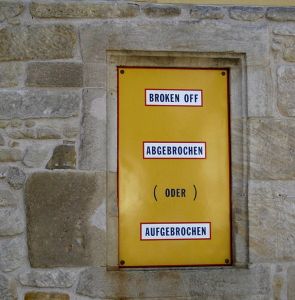
Weiner therefore made a crucial contribution to defining Conceptualism as a mode by which art could challenge and subvert the traditional object status of the work. His work from the late 1960s onwards is an example of the "dematerialization of the art object" - to use the language of art critic Lucy Lippard - whereby visual and physical form is replaced with pure language. However, Weiner came to see language itself as a sculptural material. Importantly, he also saw the use of language in art as less baggage-laden than traditional media, a means of reclaiming art for, and making it accessible to, an imagined mass audience.
During the same period Weiner also experimented with video and film, sound art, sculpture, performance art, installation art, and graphics. Often, his films include vocal recitations of statements similar to those found in his text-based sculptures. As such, they can be seen as placing his conceptual art in a different, time-bound medium, and as an important contribution to his own body of work and to early video-art.
Late Period
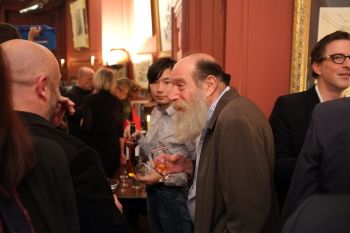
Weiner and his wife Alice spent the last several decades of the artist's life splitting their time between New York City and Amsterdam, although Weiner's struggles with cancer later made it more difficult for him to access their houseboat in the Netherlands. In New York they lived on Bleecker Street for over 30 years before moving to the West Village, into a residence in a converted bakery dating to 1910. Weiner's studio occupied the basement of the building, with his archives on the second floor.
Weiner continued to work until just before his death, travelling around the world for various projects. He gave occasional lectures over the last decades of his life but generally avoided teaching positions, as his lifelong disdain for authority meant that he disliked assuming positions of power.
The Legacy of Lawrence Weiner
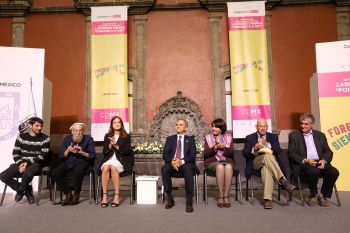
Weiner helped to define the parameters of Conceptualism, which would go on to become arguably the most influential art movement of the half century; from 1970 onward. He made crucial contributions, alongside artists such as Douglas Huebler, Robert Barry, Joseph Kosuth, and Sol LeWitt, to the idea of Post-minimalism. This terms describes a broad range of work, much of it combining some of the clinical and affectless qualities of Minimalism with more human warmth, spontaneity, and symbolism.
Although his work is rarely directly engaged with political or social themes, Weiner also maintained a subversive outlook on the world around him which was emblematic of the post-sixties worldview. Curator Dakin Hart asserts that "Lawrence Weiner has always been political[...His] interest is in the matrix of relationships that connect us with the other raw materials that constitute the world." Likewise, writer and artist Marjorie Welish states that Weiner's "words and work act as cultural irritants wherever they appear. Ranging from mildly to aggressively interventionist, Weiner's verbal art uses formalism to drive a wedge into the cultural status quo."
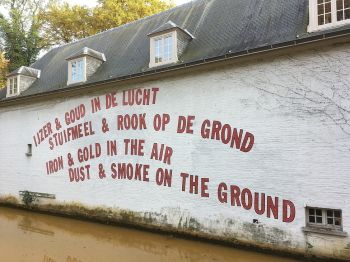
Although he has been categorized as a Conceptual artist, Weiner dislikes the designation, which he sees as another form of elitism, and instead considers himself to be a sculptor. He says "I think the Conceptual art thing is ridiculous [...L]et's stop giving things classifications so that they can be taught in expensive schools." For Weiner, language has a material reality and is "a means of presenting a mise-en-scène, a physical reality". In this way, his use of language differs from that of Barbara Kruger or Jenny Holzer, who tend to use language more as a call-to-arms, or as a means of calling out power structures within society, rather than an object in-and-of-itself.
Moreover, as art critic Robert Enright explains, Weiner's handling of language differs from that of artists such as Roni Horn and Ed Ruscha, in this it is "steadfastly uninflected, willfully incomplete and tantalizing, maybe even perverse". Enright adds that "[t]he viewer's tendency with Weiner's work is to turn the statement or phrase into a question. [...] The transition from making to apprehending [...] traces a shift from the declarative to the interrogative. That is precisely how Weiner wants his words to function; they may be descriptions or facts [...] but they are also catalysts for an interaction with the viewer/audience. In this understanding, the [work] changes from realist to magic realist. We enter into an engagement with the alchemy of words."
Influences and Connections

-
![Robert Ryman]() Robert Ryman
Robert Ryman -
![John Chamberlain]() John Chamberlain
John Chamberlain - Liam Gillick
-
![Robert Ryman]() Robert Ryman
Robert Ryman -
![John Chamberlain]() John Chamberlain
John Chamberlain - Liam Gillick
Useful Resources on Lawrence Weiner
- Lawrence Weiner (Phaidon Contemporary Artist Series)Our PickBy Lawrence Weiner
- Lawrence Weiner: Henry the Navigator in a Sea of SandBy Lawrence Weiner
- Lawrence Weiner: If in Fact There is A Context: 100 Notes, 100 Thoughts: Documenta SeriesBy Lawrence Weiner
- Lawrence Weiner - Something to Put Something OnBy Lawrence Weiner
 Ask The Art Story AI
Ask The Art Story AI





















